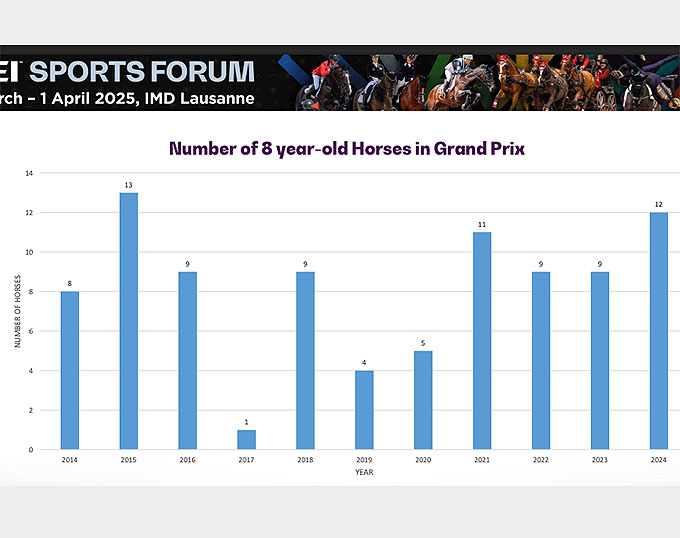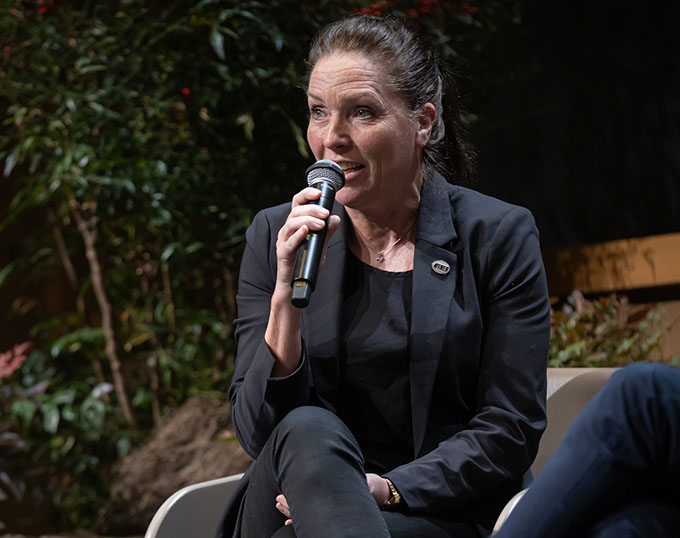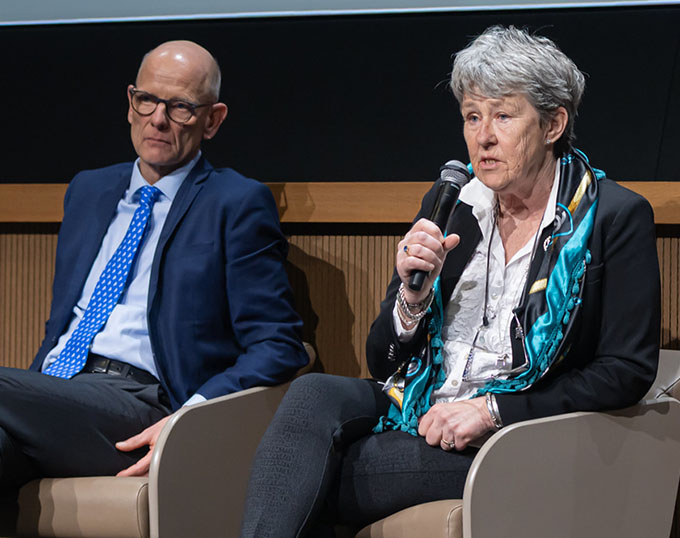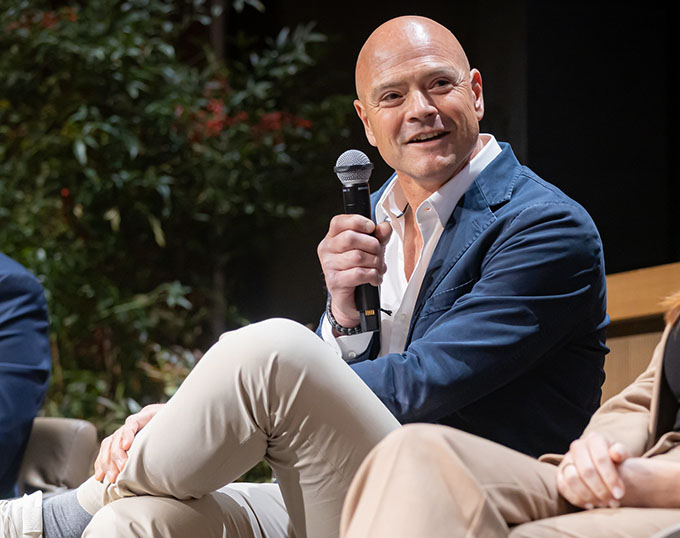
FEI press released, edited by Eurodressage (we picked out the most interesting quotes and statements from the morning dressage session. You can watch the session in full here).
FEI President Ingmar De Vos welcomed almost 300 in-person participants and a global online audience to the 14h FEI Sports Forum, which opened on 31 March 2025 at the IMD Business School in Lausanne (SUI), reaffirming the Forum’s role as a crucial platform for discussion and consultation ahead of key decisions at the FEI General Assembly later in the year.
Welfare Key Focus
Welfare is a key focus at the Sports Forum and, in his opening address, the FEI President stressed the importance of keeping equine wellbeing to the forefront at all times.
"We must be very careful when we train horses and think not about the performance, but about the welfare", he said.
Setting the stage for two days of sessions, De Vos introduced Professor Stéphane Michel, IMD Dean of Faculty of Research, who delivered a thought-provoking keynote on “Breakthroughs in Business, Sports and Life” that explored how reframing perspectives help to challenge existing assumptions to uncover new solutions.
FEI Dressage Strategic Action Planning Working Group

Ronan Murphy began his speech by presenting the statistics of 2024, stating there are over 4,000 registered dressage athletes, compared to approximately 9,000 eventing riders and 53,000 show jumping riders. They ride 5 CDI's per year on average per horse. In 2024 there were twelve 8-year old horses competing at Grand Prix level. Murphy said this figure has fluctuated between 1 and 13 over the years.
Dressage Under Attack
With dressage being under attack in equestrian and mainstream media, the Dressage Strategic Action Planning Working Group was created by the FEI to find solutions and retain the social licence to operate.

“What judges are rewarding is what being trained at home,” said Lise Berg. “What they (amateurs/grassroot level riders) are seeing their role models do is what they are going to be doing in the local riding club. (We need to) have horses that are happy and healthy. What we are seeing in the big competitions is directly influencing what we are seeing at home.”
Berg emphasised the importance of making decisions based on independent scientific research and also encouraged communication with all sectors. “It’s super important we don’t shy away from the discussion," she said. “We need to face it head on, not as a conflict but as a conversation.”
"Evidence and evidence based, this word has become weaponized," Berg stated. "We need to work knowledge-based as there is not always evidence. While we are working we still need to move forward, we need to keep pushing ourselves to have good evidence. Otherwise everything will be based on gut feeling. We also don’t need to use statistics for everything. We need a broader base of knowledge to make decisions."

Lise Berg responded that, "the definitions are not clear yet. We have a big job to find out what’s happening in these horses. We don’t have the knowledge yet. We have to be humble. We have ideas, hypotheses, but we are not guessing. We are working on this. We don’t shy away from the discussion and it seems that we are hiding and hoping the storm will blow over. It’s clearly not. What do we know, what don’t we know, where are the problems. We are seeing situations in a test that are not ideal."
Berg continued, "sometimes it's a snap shot, sometimes a video of longer periods of time. Decisions need to get adapted as we get smarter. Sure we know super tight necks are not good, but sometimes we need to ask is a horse in pain or not."
Making the Double Bridle Optional
One of the major pleas with the FEI has been to make the double bridle optional, also at Grand Prix level.
Chair George Williams said, "we are not yet making any recommendations as a group yet, we have our personal opinions about it. The full bridle is testing the rider’s expertise. It should be used by those who have the proper use/education. Horses need to be properly trained to carry it, and so do the riders.
The question was raised whether it is appropriate for a junior rider to ride with a double bridle and if these young riders have had enough to learn the skills to ride with a curb bit? Williams also added, "aso look at the age of the horses. When you see sales horses, you see 5 and 6 years old In full bridles and that’s not appropriate."

Monica Theodorescu said that in the FEI Dressage Committee "we agree to keep the double bridle compulsory in top sport, we are discussing to make it optional at GP up to 3* level. We don’t want to promote the snaffle to be used to get higher marks. To get positive press for a moment."
This was a remarkable statement that goes contrary to the general feelig amongst dressage riders that that higher points are given by judges when one rides with a double bridle, and not with a snaffle.
"For us it doesn’t change much to judge a horse in a snaffle or double," said French 5* judge Raphael Saleh. " If a horse doesn’t go in the right way it has the same consequence. In the Prix St Georges the snaffle is allowed and still most go in a double bridle."
Lise Berg stressed that one has to "focus on the rider’s skill. The horse has to be trained to carry the double, but the riders have to show that they are good enough to have the responsibility to ride in it. We have to rolling it out as carefully. Everything we do will have ripple effects. (It's best) to have a slow roll-out so we can study the consequences. National federations are already playing with these things and we can learn from them. They are our pilot projects. We can learn from that."
"Spectacular Dressage"
The majority of complains the FEI received on dressage sport entailed the "judging & assessment" of horses and the belief that the sport has veered too much away from the classical principles of dressage, celebrating harmony and lightness, over spectacular gaits.

Lise Berg stated, "maybe the desire for extravagance, excitement has moved to something that has lost the lightness. We don’t want to see a ballet dancer covered in sweat and make it look like it’s super hard. It’s not boring because it looks easy. This difference is going to be super tricky.”
More Collectives Again as a Solution?
One of the solutions to improve dressage judging that the old establishment keeps repeating and pushing for is the re-introduction of more collective marks at the bottom of the score sheet.
Scientific research has proven in the past that judges "abused" the collectives to push the riders' results in the direction they wanted (up or down), which resulted in reducing the collectives from four to one score.

French 5 judge Raphael Saleh echoed Withages' thoughts. "We judges were in favour of the collectives as it was a reflection of the whole test. With only one mark it’s not sufficient and doesn’t have enough influence on the whole picture."
Also Monica Theodorescu defended bringing back the collectives. "We as a German NF, we keep bringing up the collective marks, Austria is in the same position. It’s still a good tool to look at the principles of training. There is a lack of assessment in these principles."
Kyra Kyrklund countered this by stating, "the mark (per movement) should reflect the harmony and technical correctness."
Kyra continued, "when we looked at the code of points, we wanted (to introduce) some place (i.e. a score) that the rider was not sitting very nicely. Our recommendation was that the seat/aids would be the only collective with a coefficient, of 2 or 4, at the end. You can’t make a Fiat into a formula 1 car, but you can ride a Fiat bloody well."
On Stewarding
Also the topic of stewarding was handled. Ronan Murphy said, "we are trying for a support system for stewards, the veterinary delegate who is there, oversight by a judge, to support the stewards in their job and key is the education system."
"In the top shows it works very well," said Theodorescu. "There is good communication with the stewards, they have a wide knowledge. Lower level shows that it has to be more harmonized, same education, same standard, it also needs to go to the lower levels, juniors, ponies, parents."

Lise Berg said, "some horses can’t cope with the way they are trained," to which judge Saleh replied, "we are much more strict when horses can’t fulfil the criteria for a level. We have been too flexible in this matter to bring more people in the sport."
Andrew McLean stated that "a rider can do a lot of damage with the snaffle, but also with the curb.. The curb with a loose chain is a first-class see-saw, with a chain on it becomes a second-class lever."
Monica and Kyra agreed that "it is educating the the young people on the use of the curb. There is often ill-fitting tack and the rider doesn’t see it.
Public perception of dressage is not ideal and social media groups attack the sport.
"They are almost religious sects," said Kyra who is now for engaging in discussions on social media. "We are not going to change the mind of the chief priest there."
Goran Akerstrom, FEI Veteriniary committee chair, explained that "we are engaging with some of the groups, the scientific group, as well as with one group from the opposite direction to have a good dialogue. We are not engaging with them who oppose animals in sport, but we do with the other ones."
On the Role of Trainers and Ethical Training Methods
Klaus Roeser said, "don’t fulfil your own wishes by overtraining the horse. Treat the horse like you want to be treated."
Roly Owers of the World Horse Organisation, questioned whether dressage has a systemic problem with their training methods. "Is this what one has to do to get horses to the top of the sport? The group needs to be better able to answer that questions," said Roly.
Ronan replied, "I'm convinced it’s not a systemic problem but there are issues in the sport." Kyra agreed, "it’s not systemic. You always have some murderer going round but you can’t say everyone is a murderer. It’s a few people and now they are getting caught."
Creation of the FEI Equine Welfare Advisory Group
In keeping with the welfare and wellbeing theme, one of the key announcement was the creation of the FEI Equine Welfare Advisory Group made during Session 3. FEI Veterinary Director Göran Åkerström introduced the Group, which will be chaired by FEI Vice President and Chair of the FEI Veterinary Committee Jenny Hall.

Madeleine Campbell, independent consultant, Professor and European Veterinary Specialist and Royal College of Veterinary Surgeons (RCVS) Specialist in Animal Welfare Science, Ethics and Law, highlighted the importance of the work of the Group.
“Our belief is that the use of horses in sport is ethical provided certain key principles are fulfilled,” Professor Campbell said. “The guiding principles to which our group will be working will be to ensure that negative welfare effects are minimised, positive welfare effects are maximised, avoidable and unnecessary risks to horses are identified and mitigated, and the FEI regulations and the law are complied with.”
Blood on the Flanks, a "Scratch"?!
A final interesting debate was held at the end of the day on show jumping rule revision. Jumpers wish to see the rules changed when there is blood on the horse's flanks.
Cesar Hirsch (VEN), PAEC President, FEI Judge Level 4 and FEI Steward Level 4 , said, "there is common goal between jumpers and dressage to protect and grow the sport world wide."

Francois Mathy jr (BEL), president of the International Jumping Riders Club, believes "a scratch and a direct elimination is unfair. The proportion between the offence and the penalty is out of order." Mathy described blood by the spur (accidental or not), as a “micro lesion”. He suggested that these scratches are "not done on purpose and it should lead to a warming, not elimination."
Iris Boelhouwer, director of the Dutch Equestrian Federation, responded by saying 'how are we going to explain it to the public (referring to those scratches). In dressage it’s straight forward, but in jumping “it’s not so bad."
Stephan Ellenbruch, chair of the FEI Jumping committee, replied, "we keep the rule and procedures as such. We have a protocol for that. The riders blame the stewards that they are “looking for blood”. We are living in times where it is very difficult to explain it to the outside and inside world. The headline is the social licence and it will be difficult to explain that."
Related Links
FEI Sports Forum 2024 opens in Lausanne with Horse Welfare at Forefront of Discussions
FEI Championships, Safeguarding and Gender Equality on Day Two of 2024 FEI Sports Forum
Recommendations for "A Good Life for Horses in Equestrian Sport," Topic of Discussion at 2023 FEI Sports Forum